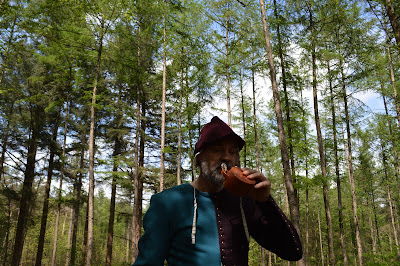We read about the project Pilgrimage21 of the Company of Saint George, the famous Swiss 15th century re-enactment group and thought this would be a marvellous idea to do some medieval re-enactment during corona times. Worldwide medieval re-enactment groups were encouraged to go on pilgrimage journeys to their local/nearby pilgrimage shrines on the feast of Saint Corona (14 May) and the weekend afterwards (15 and 16 May 2021). Photos and Videos of the preparation and the actual pilgrimage were to be shared on Facebook (CoStG: project Pilgrimage21) and Instagram (#Pilgrimage21).
Saint Corona
Illuminated miniature of the martyrdom of Saints Victor and Corona, on a full leaf from a Book of Hours, France (Paris), c. 1480.
Maria of Redichem
We were lucky to have several medieval pilgrimage places nearby: Saint Cunera in Rhenen and Maria of Redichem in Renkum, and somewhat further away the Chapel of Saint Walrick (with the koortsboom) in Overasselt. We decided to go to the church of Maria in Renkun, as the pilgrimage route is the most beautiful to walk - not much asphalt roads - and conviently was the closest and shortest route. Furthermore, the church is open every day from 9 am to 4 pm, and has a nice rosegarden with a walk along displayed icons.

The statue of Maria of Redichem, dated 1350.
Redichem (or Renkum) is a pilgrims place since 1380 thanks to the statue of Maria in a chapel to which miracle cures were attributed to. The French king Charles VI donated two relics to the chapel: a splinter from the True Cross and a thorn from the Crown of Christ. The chapel also played an important role in the life of Maria of Guelders (Marie d'Harcourt), wife of duke Reinald IV of Guelders. In 1405 she founded a convent for the sisters of Modern Devotion at the place of the chapel. The duke ordered one of the brooks (Molenbeek) to be redirected so the nuns would have a fresh water supply. Maria of Guelders frequently visited the place, for instance in 1407 together with several French courtiers.
In 1585 the convent was destroyed, but some nuns were able to keep the statue of Maria into safety. Then the statue changed hands regularly, until one collector returned it to Renkum in 1928. Now it can be found in the 'Our Lady of the Assumption' church. An embroidered cushion from 1390 that used to reside in the convent is now in the depot of the museum Catherijneconvent in Utrecht. The cushion depicts the Dedication in the temple (Luc.2:22-39).
With silk embroidered linen cushion from the Redichem convent. ABM t2060 Catherijne convent, Utrecht. 57.0 by 71 cm. These cushions were used to place (religious) books upon.

















Hi! Your blog is fascinating! I love studying medieval architecture and furniture. Please keep up the great work on this blog!
ReplyDeleteCorona happened to be a useful saint for the woodworkers as well, being the patron for lumberjacks (as well as with causes involving money, like gambling and treasure hunting). It happened that the lady Corona was martyred because she comforted (Saint) Victor, a Roman soldier who was tortured and killed for his faith.imseo
ReplyDelete